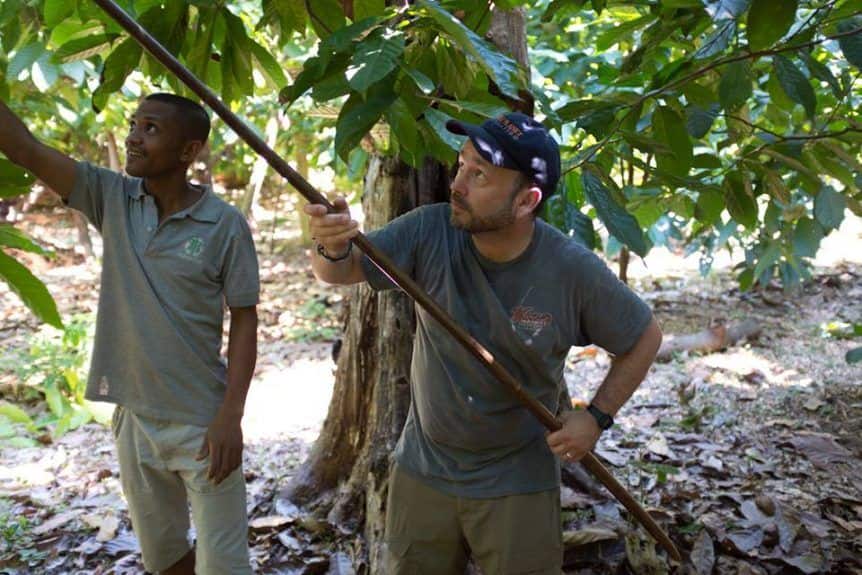Jonathan Martinek shares another beautiful story from his experience as a Whole Foods Market Team Member Volunteer in Madagascar:
 Prior to my Whole Foods Market Team Member Volunteer experience in Madagascar, I gave little thought to chocolate. As a long time professional cook and WFM TM for the last three years, chocolate was just another ingredient and occasional snack. The phrase “bean to bar” wasn’t a part of my vocabulary until a pre-trip conference call with Tim McCollum, co-founder of Whole Foods Market’s vendor partner Madécasse. Our community service project included refurbishing an elementary school building in a rural cacao
Prior to my Whole Foods Market Team Member Volunteer experience in Madagascar, I gave little thought to chocolate. As a long time professional cook and WFM TM for the last three years, chocolate was just another ingredient and occasional snack. The phrase “bean to bar” wasn’t a part of my vocabulary until a pre-trip conference call with Tim McCollum, co-founder of Whole Foods Market’s vendor partner Madécasse. Our community service project included refurbishing an elementary school building in a rural cacao
farming village, providing support to the village to build 3 clean water wells and create a school garden. These services projects enabled the WFM Team Member Volunteers to participate in and learn about the cacao growing, harvesting and post-harvest handling processing that forms the base of Madécasse chocolate.
Cacao trees are not planted in tidy rows like one sees in citrus or other fruit orchards. As we walked amongst them, it felt  much more like strolling in a forest, the ground strewn with dry leaves with dappled sunlight breaking through in spots. We later learned that the leaves are left on the ground to serve as a natural burglar alarm, alerting farmers to the ever present cacao poachers, who attempt to steal their harvest in the dead of night. We were told that our host, Lala was known to sleep in the forest at night, ready to catch would-be chocolate thieves.
much more like strolling in a forest, the ground strewn with dry leaves with dappled sunlight breaking through in spots. We later learned that the leaves are left on the ground to serve as a natural burglar alarm, alerting farmers to the ever present cacao poachers, who attempt to steal their harvest in the dead of night. We were told that our host, Lala was known to sleep in the forest at night, ready to catch would-be chocolate thieves.
Harvesting starts with cutting down the ripe pods using a long wooden pole with a curved metal blade. Pods are collected in sacks and brought back to the farm for processing.
The pods contain multiple white fruits that look a bit like hominy and taste like an under ripe mango. At the center of each is a seed which houses the actual cacao nibs. Each pod is opened by hand with a large knife or stick and the inner fruits are collected in large tubs. Workers strip the fruit pulp off to reveal the inner seeds. In a land where 90% of the population lives on under $2 a day, nothing is wasted, so the hulls of the fruit are saved and used as animal fodder.
Seeds are allowed to ferment in open wooden vats for seven to ten days, during which time they are regularly stirred and moved to different vats, ensuring complete fermentation.

Once fermented, the seeds are dried in a laborious process that involves raking them flat on hot concrete slabs which wick away moisture, followed by raking them into piles to let the concrete dry in the sun and repeating the process over and over until the ideal moisture content is achieved.
The final step, at the farm level, involves meticulously hand sorting every single seed to remove any twigs and leaves, as well as moldy or broken seeds. During this process the seeds are separated into standard and superior grades and packaged for shipping to brokers and clients. The purchasers will roast the beans and then crack them open to obtain the cacao nibs.
Founded by a pair of former Peace Corps volunteers, Whole Foods Market’s vendor partner Madécasse takes the chocolate making process beyond Fair Trade. While roughly 75% of all cacao is grown in Africa, less than 1% is actually made into chocolate there. It is generally exported as a commodity bean and made into chocolate in wealthy industrialized countries such as the United States, Switzerland or Belgium. Madécasse transforms the cacao from bean to bar in Madagascar, sourcing additional ingredients such as vanilla and sugar locally, creating jobs and supporting the Malagasy economy. Oh, and their chocolate is truly delicious! To learn more about Madécasse and the wonderful country of Madagascar check out their story here.


